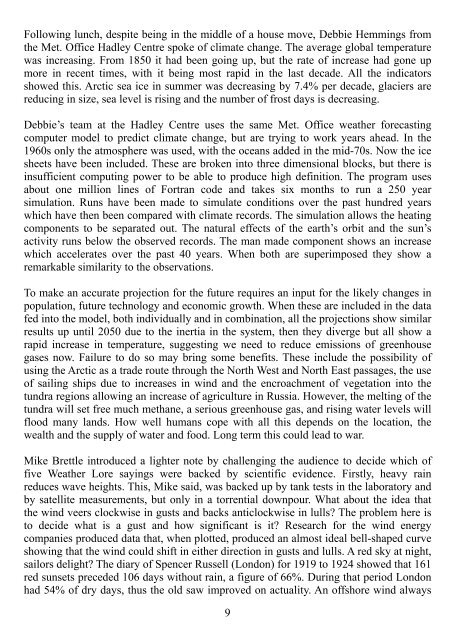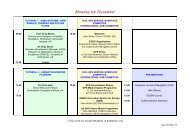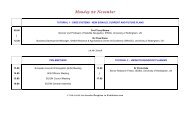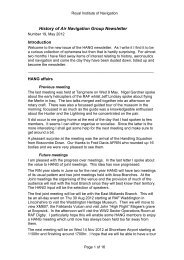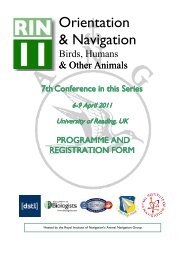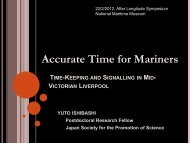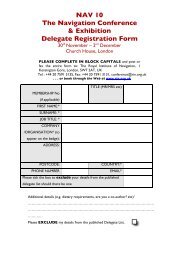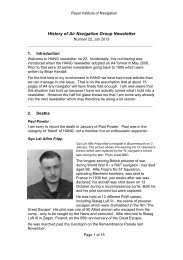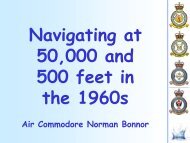Fairway 30 - Royal Institute of Navigation
Fairway 30 - Royal Institute of Navigation
Fairway 30 - Royal Institute of Navigation
Create successful ePaper yourself
Turn your PDF publications into a flip-book with our unique Google optimized e-Paper software.
Following lunch, despite being in the middle <strong>of</strong> a house move, Debbie Hemmings from<br />
the Met. Office Hadley Centre spoke <strong>of</strong> climate change. The average global temperature<br />
was increasing. From 1850 it had been going up, but the rate <strong>of</strong> increase had gone up<br />
more in recent times, with it being most rapid in the last decade. All the indicators<br />
showed this. Arctic sea ice in summer was decreasing by 7.4% per decade, glaciers are<br />
reducing in size, sea level is rising and the number <strong>of</strong> frost days is decreasing.<br />
Debbie’s team at the Hadley Centre uses the same Met. Office weather forecasting<br />
computer model to predict climate change, but are trying to work years ahead. In the<br />
1960s only the atmosphere was used, with the oceans added in the mid-70s. Now the ice<br />
sheets have been included. These are broken into three dimensional blocks, but there is<br />
insufficient computing power to be able to produce high definition. The program uses<br />
about one million lines <strong>of</strong> Fortran code and takes six months to run a 250 year<br />
simulation. Runs have been made to simulate conditions over the past hundred years<br />
which have then been compared with climate records. The simulation allows the heating<br />
components to be separated out. The natural effects <strong>of</strong> the earth’s orbit and the sun’s<br />
activity runs below the observed records. The man made component shows an increase<br />
which accelerates over the past 40 years. When both are superimposed they show a<br />
remarkable similarity to the observations.<br />
To make an accurate projection for the future requires an input for the likely changes in<br />
population, future technology and economic growth. When these are included in the data<br />
fed into the model, both individually and in combination, all the projections show similar<br />
results up until 2050 due to the inertia in the system, then they diverge but all show a<br />
rapid increase in temperature, suggesting we need to reduce emissions <strong>of</strong> greenhouse<br />
gases now. Failure to do so may bring some benefits. These include the possibility <strong>of</strong><br />
using the Arctic as a trade route through the North West and North East passages, the use<br />
<strong>of</strong> sailing ships due to increases in wind and the encroachment <strong>of</strong> vegetation into the<br />
tundra regions allowing an increase <strong>of</strong> agriculture in Russia. However, the melting <strong>of</strong> the<br />
tundra will set free much methane, a serious greenhouse gas, and rising water levels will<br />
flood many lands. How well humans cope with all this depends on the location, the<br />
wealth and the supply <strong>of</strong> water and food. Long term this could lead to war.<br />
Mike Brettle introduced a lighter note by challenging the audience to decide which <strong>of</strong><br />
five Weather Lore sayings were backed by scientific evidence. Firstly, heavy rain<br />
reduces wave heights. This, Mike said, was backed up by tank tests in the laboratory and<br />
by satellite measurements, but only in a torrential downpour. What about the idea that<br />
the wind veers clockwise in gusts and backs anticlockwise in lulls? The problem here is<br />
to decide what is a gust and how significant is it? Research for the wind energy<br />
companies produced data that, when plotted, produced an almost ideal bell-shaped curve<br />
showing that the wind could shift in either direction in gusts and lulls. A red sky at night,<br />
sailors delight? The diary <strong>of</strong> Spencer Russell (London) for 1919 to 1924 showed that 161<br />
red sunsets preceded 106 days without rain, a figure <strong>of</strong> 66%. During that period London<br />
had 54% <strong>of</strong> dry days, thus the old saw improved on actuality. An <strong>of</strong>fshore wind always<br />
9


